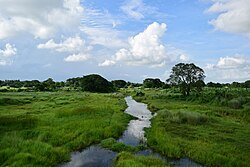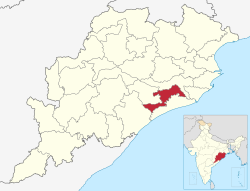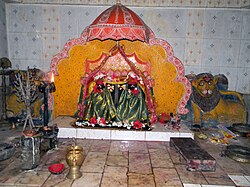Khordha district
Thank you for being part of the Bharatpedia family! 0% transparency: ₹0 raised out of ₹100,000 (0 supporter) |
Khordha district
Khurda | |
|---|---|
 | |
| Nickname: Paika District of Odisha[citation needed] | |
 Location in Odisha, India | |
| Coordinates: 20°09′58″N 85°39′58″E / 20.166°N 85.666°ECoordinates: 20°09′58″N 85°39′58″E / 20.166°N 85.666°E | |
| Country | |
| State | |
| Headquarters | Khordha |
| Government | |
| • Collector & District Magistrate | Sanat kumar Mohanty, OAS(SAG) |
| • Superintendent of Police | Raj Kishore Dora, OPS(S) |
| Area | |
| • Total | 2,887.5 km2 (1,114.9 sq mi) |
| Population (2011) | |
| • Total | 2,251,673[1] |
| • Density | 800/km2 (2,000/sq mi) |
| Languages | |
| • Official | Odia, English |
| Time zone | UTC+5:30 (IST) |
| PIN | 751 xxx, 752 xxx |
| Telephone code | 674, 6755, 6756 |
| Vehicle registration | OD-02/OD-33 |
| Nearest city | Bhubaneswar |
| Sex ratio | 1.108 ♂/♀ |
| Literacy | 87.51% |
| Lok Sabha constituency | 2 |
| Vidhan Sabha constituency | 6 |
| Climate | Aw (Köppen) |
| Precipitation | 1,443 millimetres (56.8 in) |
| Avg. summer temperature | 41.4 °C (106.5 °F) |
| Avg. winter temperature | 9.5 °C (49.1 °F) |
| Website | www |
Khordha district is an administrative division of the state of Odisha, India. It was formed on April 1, 1993, by the division of former Puri District into Puri, Khordha and Nayagarh districts. In the year 2000 the district name was changed to Khordha. The district headquarters is Khordha Town. The capital city of Bhubaneswar is located in this district.[2] Khordha is the most urbanized of all the districts of Odisha.
Khordha Road, the railway station that serves the town, is also the divisional headquarters of the East Coast Railway of the Indian Railways, and contains its own division. Khordha is known for its brass utensils, cottage industries, railway coach manufacturing and cable manufacturing unit.
History[edit]
It was the capital of Odisha from 1568 to 1803. It is also known for its fort, often described as the "last independent fort". The commander who kept it free from British East India Company was ), Bakshi Jagabandhu, popularly called 'Paika Bakshi'.
The Savaras tribal group, who are still to be found in the district in some pockets, once heavily populated the area. Khurda came into prominence when the first Rajas of the Khordha dynasty, Ramachandra Deva, made it the capital of his kingdom during the last part of the 16th century. Khurda suffered repeated onslaughts from Muslim and Maratha cavalry but its royal house retained independence till 1804, when the British East India Company dispossessed Raja of his territory following the Second Anglo-Maratha War.
British government took Odisha under its rule in 1803 but could only include Khurda in 1827. The Paikas of Khurda are known for protesting against the British rule in Odisha.
Geography[edit]
It is also the district headquarters of Khurda district located at 20.11° N 85.40° E. The area of the district is 2,888 km2 (1,115 sq mi).[2] The district is bordered by Cuttack district to the north and east, Puri district to the south, Ganjam district to the west, and Nayagarh district to the northwest. The Daya and Kuakhai Rivers flow through Khurda. The forested area is 618.67 km2 (238.87 sq mi).[3] The district is mainly flat coastal plain, with some hill ranges in the west. It borders the Chilika Lake.
Climate[edit]
| Bhubaneswar | ||||||||||||||||||||||||||||||||||||||||||||||||||||||||||||
|---|---|---|---|---|---|---|---|---|---|---|---|---|---|---|---|---|---|---|---|---|---|---|---|---|---|---|---|---|---|---|---|---|---|---|---|---|---|---|---|---|---|---|---|---|---|---|---|---|---|---|---|---|---|---|---|---|---|---|---|---|
| Climate chart (explanation) | ||||||||||||||||||||||||||||||||||||||||||||||||||||||||||||
| ||||||||||||||||||||||||||||||||||||||||||||||||||||||||||||
| ||||||||||||||||||||||||||||||||||||||||||||||||||||||||||||
Economy[edit]
It is renowned for its brass utensils cottage industries, cable factory, spinning mills, watch repairing factory, railway coach repairing factory, oil industries, Coca-Cola bottling plant and small metal industries, or sms group, Iocl gas bottling plant.
Divisions[edit]
- Parliamentary constituencies: 2
- Assembly constituencies: 6
- Subdivisions: 2[3]
- Villages: 1,561[3]
- Blocks: 10[3]
- Grama panchayat: 168[3]
- Tehsils: 08[3]
- Towns: 6[3]
Tehsils[edit]
- Balianta
- Balipatna
- Banapur
- Begunia
- Bhubaneswar
- Bolagarh
- Chilika
- Jatni
- Khordha
- Tangi
Subdivisions[edit]
- Bhubaneswar: consists of 4 blocks, viz. Balianta, Balipatana, Jatni, Bhubaneswar.
- Khurda: consists of 6 blocks, viz. Tangi, Khorda sadara, Banapur, Begunia, Bolgarh and Chilika.
Demographics[edit]
According to the 2011 census Khordha district has a population of 2,251,673,[4] roughly equal to the nation of Latvia[5] or the US state of New Mexico.[6] This gives it a ranking of 201st in India (out of a total of 640).[4] The district has a population density of 799 inhabitants per square kilometre (2,070/sq mi).[4] Its population growth rate over the decade 2001-2011 was 19.65%.[4] Khordha has a sex ratio of 925 females for every 1000 males,[4] and a literacy rate of 87.51%.[4]
At the time of the 2011 Census of India, 92.13% of the population in the district spoke Odia, 1.98% Urdu, 1.69% Telugu, 1.65% Hindi, 1.38% Bengali and 0.43% Santali as their first language.[7]
Hindus-88.5%, Jain-4.5%, Muslims-2.5, Sikh-2.0%, Christians-1.5%, others-1% (including Buddhists)
| Year | Pop. | ±% p.a. |
|---|---|---|
| 1901 | 470,409 | — |
| 1911 | 479,645 | +0.19% |
| 1921 | 431,482 | −1.05% |
| 1931 | 478,128 | +1.03% |
| 1941 | 516,719 | +0.78% |
| 1951 | 557,718 | +0.77% |
| 1961 | 658,073 | +1.67% |
| 1971 | 858,554 | +2.70% |
| 1981 | 1,132,182 | +2.81% |
| 1991 | 1,502,014 | +2.87% |
| 2001 | 1,877,395 | +2.26% |
| 2011 | 2,251,673 | +1.83% |
| source:[8] | ||
Tourist attractions and nearby places of interest[edit]
- Arikama: Village Arikama under Bolagarh block is famous for Maa Koshalsuni mandir in the forest. This green forest is protected by villagers of Arikama, Thanapalli etc. It is a picnic spot. The annual festival on Mahasthami, Raja festival, annual Yagna are some of the festivals observed by the villagers. It is around 28 km (17 mi) away from Khurda and lies on Rajsunakhala Dhalapathar Road. It is around 5 km (3.1 mi) from Dhalapathar and 9 km from Rajsunakhala.
- Atri (Hot Spring): It is situated in the village of Baghamari, at the distance of 42 km from Bhubaneswar and nearly 14 km from Khordha bus stand. It is famous for its sulfur-water springs and a temple dedicated to Lord Hatakeswara (Lord Shiva).
- Banapur: Banapur is famous for Maa Bhagabati (one of the incarnation of Hindu Goddess Maa Durga) temple. On display is a heavy iron piece that floats on water.
- Barunei: This temple is situated on the famous Barunei hills. It is at a distance of 28 km from Bhubaneswar. Goddess Barunei is the famous deity of Khurda. A stream flows from the hills which is known as Swarna Ganga. This place is one of the most significant historic places of Odisha.[citation needed]
- Bhubaneswar: It is the capital city of Odisha, which was also known in the ancient times as the Kingdom of Kalinga. Bhubaneswar is popularly known as the Temple City of India due to its large number of ancient temples (most notable among them being Lingaraj Temple, Khandagiri, Kedar Gouri, Ram Mandir, etc.). This city also features attractions like: Odisha State Museum, Bindusagar Tank, Rabindra Mandap, Raj Bhavan, Legislative Assembly, Nandankanan, City Parks and Gardens, etc. This is one of the major shopping centers in Odisha.
- Buddhanath Temple: An 11th-century temple dedicated to the Hindu god Shiva located near the town of Balipatna about 25 km from Bhubaneswar
- Chilika: Situated at a distance of 100 km from the state capital Bhubaneswar, Chilika (or Chilka)
- Deras and Jhumka: These are two picnic spots situated at a distance of 15 km from Bhubaneswar. They are two dams surrounded by a dense forest on three sides. It is popular with picnickers during winter.[citation needed]
- Sundarpur Muketashwar: Maa Mangala Temple
- Dhauligiri: It is situated at a distance of 15 km from Bhubaneswar. The rock edict of Dhauli bears the early history of Kalinga and this rock edict was engraved by Emperor Ashoka.
- Garamanitri: It is situated at a distance of 18 km form Khordha. Vaia Dalatola-Garamanitri is famous for Maa Ramchandi temple( ଶକ୍ତି ପୀଠ ମା ରାମଚଣ୍ଡୀ) and is a picnic spot.
- Golabai: Golabai Sasan is known mostly from its medieval temple architecture. This settlement site is located on the left bank of the Mandakini (locally Mallaguni) river, near the Chilka lake. Trial excavations in 1991 showed a succession of Chalcolithic and Iron Age assemblages, presumably dating to the 2nd and 1st millennia BC. The pottery as dull red and grey wares. Ground lithics bring to mind those of East and South-east Asia. This site and Sankarjang are the main sites in Odisha which represent this time.
- Guapur: Located midway between Bhubaneshwar and Puri, this village is accessible through a road to the east of the highway. It is 20 km (12 mi) from Bhubaneshwar.
- Hatabasta: Village Hatabasta (Srichandanpurpatna) is 3 km (1.9 mi) from Raj-Sunakhala and known for Goddess Maa Jogamaya. There is a big pond which is covered with lotus flowers in all seasons; known as Bada Pokhari where Lord Sapaneswar worshipped by the villager of Hatabasta. Many festivals are celebrated in this village such as "Jhamu Yatra","Rama Lila","Kartika Purnima"
- Kaipadar: Kaipadar is 15 km from Khurda. A mosque is present here. This place is the meeting place of Hindus and Muslims.
- Khandagiri and Udayagiri: These twin hills are situated in Bhubaneswar. There are 117 caves in these twin hills. The Rani Gumpha is the largest cave in the Udaygiri hill. Another cave called the Hati Gumpha contains rocks engraved with Hathigumpha inscription by King Kharavela. These caves contain a Barabhuja temple and a Jain temple.
- Lingaraja Temple: Lingaraja temple is the largest Shiva temple in Odisha. A couple of other temples exist there around it.
- Maa Ugra Tara: This temple is located in between Rameswar chowk and chandpur (Tangi block) in NH-5 and 55 km from Bhubaneswar towards Balugaon and 35 km from Balugaon towards BBSR. It is a location for picnics and also movie shooting.[citation needed] Maa ugratara is the deity of entire Tangi block. Nearby, the village Bhusandpur is the largest village among Odisha. This place is famous for fishermen's ground, because Chilika Lake is near this village.
- Nandankanan Zoo: This is a zoo of Odisha situated at a distance of 20 km from Bhubaneswar. It is famous for the botanical garden, zoo, and natural lake. The recently opened natural lion safari is the largest of its kind in India.
- Shishupalgarh: Located 13 km from Bhubaneswar. The ruined fort Shishupalgarh and ancient capital of Kalinga named Toshali are being discovered by the Archaeological Survey of India.
- Shikhar Chandi: Located 15 km from Bhubaneswar towards Nandankanan. A temple dedicated to Goddess Chandi on the hiltop can be found here.[citation needed]
- Maa Kosalasuni Temple : This place is 45 km from Bhubaneswar and 20 km from Khordha near side of NH-Khordha-Kalapathar road.
- Also 12 km from Rajsunakhala.
Politics[edit]
Vidhan sabha constituencies[edit]
The following are the eight Vidhan sabha constituencies[9][10] of Khordha district and the elected members[11] of that area
| No. | Constituency | Reservation | Extent of the Assembly Constituency (blocks) | Member of 14th Assembly | Party |
|---|---|---|---|---|---|
| 111 | Jayadev | SC | Balianta, Balipatna | Sashi Bhusan Behera | BJD |
| 112 | Bhubaneswar Central (Madhya) | None | Bhubaneswar MC Ward No. 16 to 29 and 35 to 37 | Bijaya Kumar Mohanty | BJD |
| 113 | Bhubaneswar North (Uttar) | None | Bhubaneswar (MC) (part), Bhubaneswar (part) | Priyadarshi Mishra | BJD |
| 114 | Ekamra-Bhubaneswar | None | Bhubaneswar (MC) (part), Bhubaneswar (part) | Ashok Chandra Panda | BJD |
| 115 | Jatani | None | Jatani (M), Jatani, Khurda (PART), Bhubaneswar (part) | Suresh Kumar Routray | INC |
| 116 | Begunia | None | Begunia, Bologarh | Raja sahoo | BJD |
| 117 | Khurda | None | Khurda (M), Tangi, Khurda (part) | Yotirindra Nath Mitra | BJD |
| 118 | Chilika | None | Balugaon (NAC), Banapur (NAC), Chilika, Banapur, | Prasant Jagdev | BJD |
Lok Sabha constituencies[edit]
During 1952 general election, Pandit Lingraj Mishra was elected from the Khurda (Lok Sabha constituency). 1957 onwards members were elected from Bhubaneswar (Lok Sabha constituency).[12]
References[edit]
- ↑ http://www.census2011.co.in/census/district/410-khordha.html
- ↑ 2.0 2.1 Swain, S; et al. (2018). Development of an ARIMA Model for Monthly Rainfall Forecasting over Khordha District, Odisha, India. pp. 325–331). doi:10.1007/978-981-10-8636-6_34. ISBN 978-981-10-8635-9.
{{cite book}}:|journal=ignored (help) - ↑ 3.00 3.01 3.02 3.03 3.04 3.05 3.06 3.07 3.08 3.09 3.10 "Introduction". Khordha district official website. Archived from the original on 2008-10-02. Retrieved 2008-09-12.
- ↑ 4.0 4.1 4.2 4.3 4.4 4.5 "District Census 2011". Census2011.co.in. 2011. Retrieved 2011-09-30.
- ↑ US Directorate of Intelligence. "Country Comparison: Population". Retrieved 2011-10-01.
Latvia 2,204,708 July 2011 est.
- ↑ "2010 Resident Population Data". U. S. Census Bureau. Archived from the original on 2013-10-19. Retrieved 2011-09-30.
New Mexico - 2,059,179
- ↑ 2011 Census of India, Population By Mother Tongue
- ↑ Decadal Variation In Population Since 1901
- ↑ Assembly Constituencies and their EXtent
- ↑ Seats of Odisha
- ↑ "List of Member in Fourteenth Assembly". ws.ori.nic.in. Archived from the original on 2 May 2007. Retrieved 19 February 2013.
- ↑ "First Lok Sabha - State wise Details - Odisha". Retrieved 20 December 2017.




